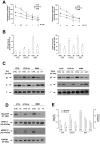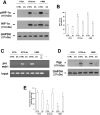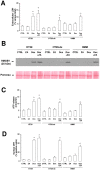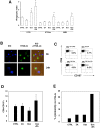Zoledronic acid restores doxorubicin chemosensitivity and immunogenic cell death in multidrug-resistant human cancer cells
- PMID: 23593363
- PMCID: PMC3625183
- DOI: 10.1371/journal.pone.0060975
Zoledronic acid restores doxorubicin chemosensitivity and immunogenic cell death in multidrug-resistant human cancer cells
Retraction in
-
Retraction: Zoledronic Acid Restores Doxorubicin Chemosensitivity and Immunogenic Cell Death in Multidrug-Resistant Human Cancer Cells.PLoS One. 2020 Dec 15;15(12):e0244194. doi: 10.1371/journal.pone.0244194. eCollection 2020. PLoS One. 2020. PMID: 33320892 Free PMC article. No abstract available.
Abstract
Durable tumor cell eradication by chemotherapy is challenged by the development of multidrug-resistance (MDR) and the failure to induce immunogenic cell death. The aim of this work was to investigate whether MDR and immunogenic cell death share a common biochemical pathway eventually amenable to therapeutic intervention. We found that mevalonate pathway activity, Ras and RhoA protein isoprenylation, Ras- and RhoA-downstream signalling pathway activities, Hypoxia Inducible Factor-1alpha activation were significantly higher in MDR+ compared with MDR- human cancer cells, leading to increased P-glycoprotein expression, and protection from doxorubicin-induced cytotoxicity and immunogenic cell death. Zoledronic acid, a potent aminobisphosphonate targeting the mevalonate pathway, interrupted Ras- and RhoA-dependent downstream signalling pathways, abrogated the Hypoxia Inducible Factor-1alpha-driven P-glycoprotein expression, and restored doxorubicin-induced cytotoxicity and immunogenic cell death in MDR+ cells. Immunogenic cell death recovery was documented by the ability of dendritic cells to phagocytise MDR+ cells treated with zoledronic acid plus doxorubicin, and to recruit anti-tumor cytotoxic CD8+ T lymphocytes. These data indicate that MDR+ cells have an hyper-active mevalonate pathway which is targetable with zoledronic acid to antagonize their ability to withstand chemotherapy-induced cytotoxicity and escape immunogenic cell death.
Conflict of interest statement
Figures







Similar articles
-
Simvastatin and downstream inhibitors circumvent constitutive and stromal cell-induced resistance to doxorubicin in IGHV unmutated CLL cells.Oncotarget. 2015 Oct 6;6(30):29833-46. doi: 10.18632/oncotarget.4006. Oncotarget. 2015. PMID: 26284584 Free PMC article.
-
Self-assembling nanoparticles encapsulating zoledronic acid revert multidrug resistance in cancer cells.Oncotarget. 2015 Oct 13;6(31):31461-78. doi: 10.18632/oncotarget.5058. Oncotarget. 2015. PMID: 26372812 Free PMC article.
-
Zoledronic acid overcomes chemoresistance and immunosuppression of malignant mesothelioma.Oncotarget. 2015 Jan 20;6(2):1128-42. doi: 10.18632/oncotarget.2731. Oncotarget. 2015. PMID: 25544757 Free PMC article.
-
Zoledronic acid-encapsulating self-assembling nanoparticles and doxorubicin: a combinatorial approach to overcome simultaneously chemoresistance and immunoresistance in breast tumors.Oncotarget. 2016 Apr 12;7(15):20753-72. doi: 10.18632/oncotarget.8012. Oncotarget. 2016. PMID: 26980746 Free PMC article.
-
Tumor microenvironment and epithelial mesenchymal transition as targets to overcome tumor multidrug resistance.Drug Resist Updat. 2020 Dec;53:100715. doi: 10.1016/j.drup.2020.100715. Epub 2020 Jun 20. Drug Resist Updat. 2020. PMID: 32679188 Review.
Cited by
-
Increasing intratumor C/EBP-β LIP and nitric oxide levels overcome resistance to doxorubicin in triple negative breast cancer.J Exp Clin Cancer Res. 2018 Nov 27;37(1):286. doi: 10.1186/s13046-018-0967-0. J Exp Clin Cancer Res. 2018. PMID: 30482226 Free PMC article.
-
Simvastatin and downstream inhibitors circumvent constitutive and stromal cell-induced resistance to doxorubicin in IGHV unmutated CLL cells.Oncotarget. 2015 Oct 6;6(30):29833-46. doi: 10.18632/oncotarget.4006. Oncotarget. 2015. PMID: 26284584 Free PMC article.
-
Self-assembling nanoparticles encapsulating zoledronic acid revert multidrug resistance in cancer cells.Oncotarget. 2015 Oct 13;6(31):31461-78. doi: 10.18632/oncotarget.5058. Oncotarget. 2015. PMID: 26372812 Free PMC article.
-
ABCA1/ABCB1 Ratio Determines Chemo- and Immune-Sensitivity in Human Osteosarcoma.Cells. 2020 Mar 6;9(3):647. doi: 10.3390/cells9030647. Cells. 2020. PMID: 32155954 Free PMC article.
-
Abraxane, the Nanoparticle Formulation of Paclitaxel Can Induce Drug Resistance by Up-Regulation of P-gp.PLoS One. 2015 Jul 16;10(7):e0131429. doi: 10.1371/journal.pone.0131429. eCollection 2015. PLoS One. 2015. PMID: 26182353 Free PMC article.
References
-
- Swanson KM, Hohl RJ (2006) Anti-Cancer Therapy: Targeting the Mevalonate Pathway. Curr Cancer Drug Targets 6: 15–37. - PubMed
-
- Gottesman MM, Fojo T, Bates SE (2002) Multidrug resistance in cancer: role of ATP-dependent transporters. Nat Rev Cancer 2: 48–58. - PubMed
-
- Troost J, Lindenmaie J, Haefeli WE, Weiss J (2004) Modulation of cellular cholesterol alters P-glycoprotein activity in multidrug-resistant cells. Mol Pharmacol 66: 1332–1339. - PubMed
Publication types
MeSH terms
Substances
LinkOut - more resources
Full Text Sources
Other Literature Sources
Research Materials

